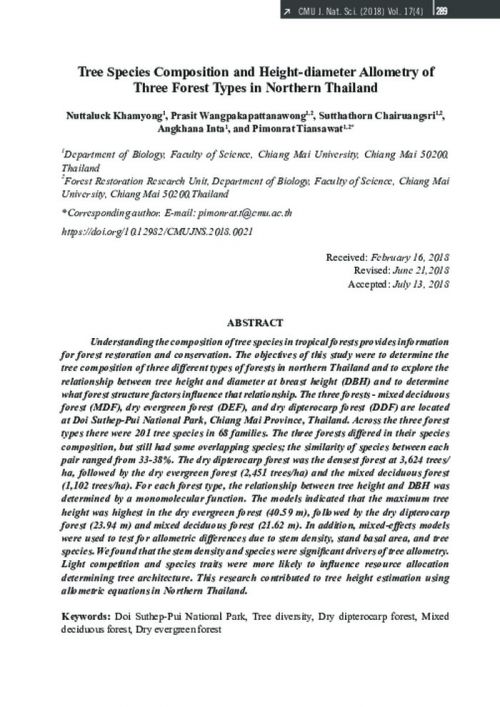Tree species composition and height-diameter allometry of three forest types in northern Thailand

FORRU Contributors
ABSTRACT: Understanding the tree species composition of tropical forests provides information for forest restoration and conservation. The objectives of this study were to determine the tree composition of three different forest types in northern Thailand; to explore the relationship between tree height and diameter at breast height (DBH) and to determine what forest structural factors influence that relationship. The three forests - mixed deciduous forest (MDF), dry evergreen forest (DEF) and dry dipterocarp forest (DDF) are located at Doi Suthep-Pui National Park, Chiang Mai Province, Thailand. Across the three forest types there were 201 tree species in 68 families. The three forests differed in their species composition, but still had some overlapping species; the similarity of species between each pair ranged from 33-38%. The dry dipterocarp forest was the densest forest at 3,624 trees/ ha, followed by the dry evergreen forest (2,451 trees/ha) and the mixed deciduous forest (1,102 trees/ha). For each forest type, the relationship between tree height and DBH was determined by a monomolecular function. The models indicated that the maximum tree height was highest in the dry evergreen forest (40.59 m), followed by the dry dipterocarp forest (23.94 m) and mixed deciduous forest (21.62 m). In addition, mixed-effects models were used to test for allometric differences due to stem density, stand basal area, and tree species. Stem density and species were significant drivers of tree allometry. Light competition and species traits were more likely to influence resource allocation determining tree architecture. This research contributed to tree height estimation using allometric equations in northern Thailand.



